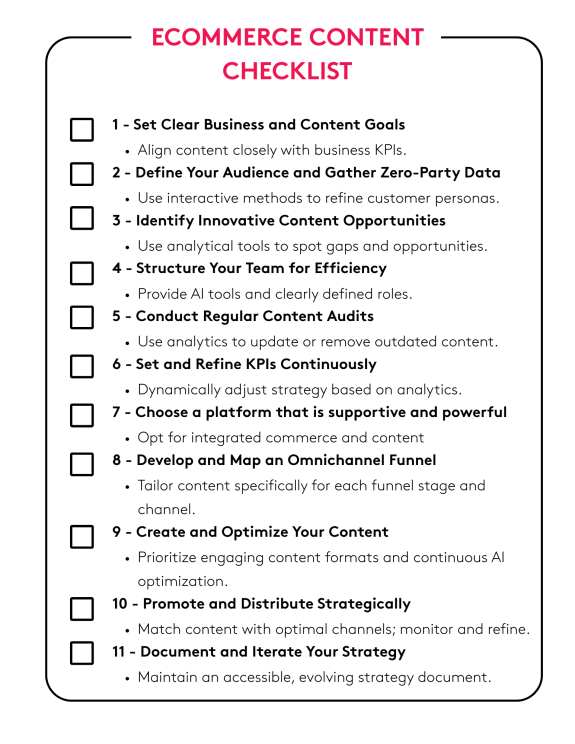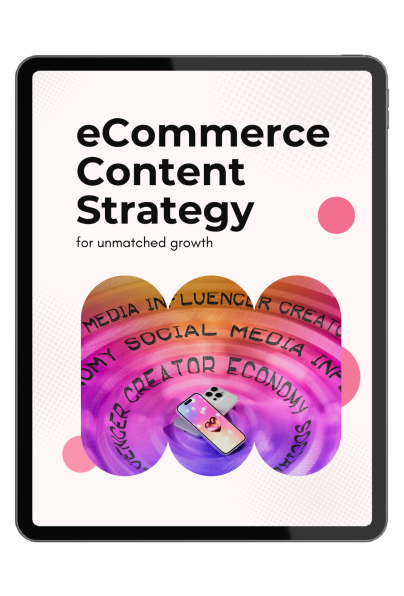eCommerce Content Strategy: A Guide for Digital Teams

In today's world, ecommerce without content means invisible brand. So whether your are just starting off or have established eCommerce operations, making sure you have a solid ecommerce content strategy will help you increase customer acquisition, retention, and revenue growth.
We created this guide to showcase what a structured approach to building a sustainable, data-informed content strategy tailored specifically for eCommerce looks like.
It combines practical planning steps with modern tactics drawn from real-world use cases, covering everything from AI-powered content creation and SEO for AI search, to omnichannel alignment and agile production workflows.
Whether you're building a new strategy or refining an existing one, this guide will help you connect the dots between content, commerce, and customer experience.
Key takeaways
- Content drives growth as it's central to acquisition, retention, and revenue.
- Know your audience and use real data to create relevant, personalized content.
- Match content to the funnel to serve the right message at each stage.
- Use AI and automation to scale faster without losing quality.
- Execution matters and strategy works when teams, tools, and processes align.
On this page:
Why you should care about eCommerce content strategy
The way people shop online has fundamentally changed and the decision process is not linear. Information is more accessible than ever before: from reddit threads to amazon reviews and whatsapp groups, consumers are no longer just browsing product listings.
They're engaging with content, reading blog posts, watching videos, and interacting with social media to inform their purchasing decisions.
This is why it matters for your brand to be present at the right moment in the right format. For instance, a well-crafted blog post can answer a customer's question, a product video can showcase features in action, and a social media post can highlight user experiences. These content pieces not only build trust but also guide customers through the buying journey, ultimately driving sales.
And we are not just talking about buying a tshirt online, this shift impacts B2B eCommerce as much as it does B2C. Business buyers now expect the same level of informative and engaging content as consumers do. They seek detailed product information, case studies, and thought leadership articles to make informed decisions.
A robust content strategy in B2B eCommerce can position your brand as an industry leader and build lasting relationships with clients.
A strategic approach to content in eCommerce is no longer optional, it's a necessity. It enhances visibility, builds credibility, and directly influences purchasing behavior across both B2C and B2B markets.
Your Step-by-Step Plan for eCommerce Content Strategy
Whether you’re launching a new online store or refining an existing one, this content strategy plan will help you create, distribute, and scale content that drives conversions and long-term loyalty.
1. Define Your Business and Content Goals
Before creating content, get crystal clear on what you’re trying to achieve. Your content strategy should align with your eCommerce goals—whether that’s boosting average order value, increasing email subscribers, or improving SEO rankings.
Ask yourself:
- What’s our primary business goal this quarter?
- What role does content play in supporting that goal?
- Are we looking to increase traffic, conversions, or retention?
Tip: Tie content metrics (like blog traffic or click-through rates) to revenue metrics. For example: “We want to grow organic traffic 30% to increase sales by 10%.”
2. Know Your Audience and Define Buyer Personas
The best content solves real problems for real people. Use customer interviews, support tickets, on-site behavior, and zero-party data (like quizzes and post-purchase feedback) to build out detailed buyer personas.
Include:
- Demographics (age, location, profession)
- Goals and pain points
- Preferred content formats (video, blog, short-form, email)
- Decision-making behaviors
Tip: Don’t just assume—use tools like Typeform, Octane AI, or Klaviyo’s preference centers to gather direct insights.
3. Audit Your Existing Content
A content audit helps you understand what you already have, what’s working, and what needs improvement. Evaluate each piece based on traffic, engagement, conversion rate, and alignment with current goals.
Use tools like:
- Google Analytics + GSC (performance data)
- Screaming Frog (SEO health)
- MarketMuse or Clearscope (topic coverage and quality)
- Ahrefs or SEMrush (backlink and keyword data)
Label each asset as:
- Keep (high-performing or evergreen)
- Improve (good topic but needs optimization)
- Repurpose (turn into a video, carousel, email)
- Remove (outdated or irrelevant)
4. Map Content to the eCommerce Funnel
Every content asset should have a role in your customer journey. Don’t just create for SEO—create for intent. Map content to each funnel stage:
Funnel Stage | Content Types |
Awareness | Blog posts, Social media, infographics, events, paid ads |
Consideration | Comparison pages, UGC, interactive quizzes, product videos |
Conversion | Product pages, reviews, FAQs, landing pages |
Loyalty | Post-purchase emails, how-to content, loyalty program pages |
Tip: Use email flows and retargeting to support each stage with the right message at the right time.
5. Choose a Scalable Content Platform
Your CMS and eCommerce platform can make or break your strategy. Look for a system that:
- Allows non-technical users to create and publish content easily
- Supports real-time personalization
- Unifies content and commerce (like Core dna)
- Enables A/B testing, analytics, and workflow automation
- Supports multiple sites or regions, if needed
Tip: Avoid content silos. A unified platform means your team can move faster and stay consistent across channels.

8 Advanced Tactics to Level Up Your eCommerce Content Strategy
Once you’ve laid the foundation for your eCommerce content strategy, these advanced tactics will help you scale, automate, and personalize your approach for maximum impact.
1. AI-Powered Content Creation
AI tools have moved far beyond buzzword status. They're now a core part of efficient content production. Tools like ChatGPT and Jasper can generate product descriptions, ad copy, email variations, and even first-draft blog posts in minutes. Meanwhile, platforms like MarketMuse and INK analyze your content’s quality and predict how well it will perform in search rankings.
AI also plays a role in design. Tools like Adobe Firefly and Canva’s Magic Design make it easy to generate branded visuals and videos at scale.
Tip: Use AI to handle repetitive tasks (like writing hundreds of product variations), but always review for tone, accuracy, and brand alignment.
2. Short-Form Video & Interactive Content
You can not escape video. It’s one of the most consumed content formats in eCommerce. Platforms like TikTok, Instagram Reels, and YouTube Shorts dominate attention spans and offer powerful organic reach.
Creating short, engaging videos (like a 15-second product demo or a customer reaction video) can significantly boost brand recall and conversions. Combine this with interactive tools like product recommendation quizzes or polls, and you’re not just entertaining users, you’re learning about them too.
Tools like CapCut, VEED.io, and Descript help you produce high-quality content without needing a pro video editor.
Tip: Repurpose long-form content (webinars, tutorials, etc.) into bite-sized clips for multi-channel use.
3. Zero-Party Data Personalization
Zero-party data is information customers willingly provide, like quiz results, preferences, or answers in a chatbot. Unlike cookies or tracking pixels, this data is both ethical and precise.
Use it to tailor messaging across touchpoints:
- Segment email lists based on quiz responses
- Send SMS alerts for restocks on favorite products
- Recommend products dynamically on-site
Platforms such as Octane AI, Typeform, and Klaviyo make it easy to collect and apply this data in your campaigns.
Tip: Offer value in return, like personalized recommendations, exclusive offers, or loyalty points—to increase participation.
4. Omnichannel Content Alignment
Omnichannel content means you have a strategy for every channel your target audience interacts with: websites, emails, ads, apps, and social platforms.
Omnichannel content alignment goes even further as it ensures that you are not just reposting the same stuff everywhere but thinking about it strategically. Your campaigns need to be consistent yet feel tailored to reach channel.
A good start would be a centralized content calendar and align campaigns across departments. Use short messages for mobile and social, and deeper storytelling for blog or email.
Platforms like Core dna are built to unify CMS and commerce, making it easier to manage consistent messaging across all customer touchpoints from one place.
Tip: Tailor content format and tone per channel, but keep the core message consistent.
5. B2B Content Tactics
B2B buyers are just as digitally savvy as consumers—often more so. They research extensively, expect tailored experiences, and look for content that helps justify their purchasing decisions internally.
If you serve B2B customers, your content strategy should include:
- Educational content: White papers, industry trends, ROI calculators
- Sales enablement assets: Product one-pagers, technical docs, pitch decks
- ABM content: Landing pages customized for specific accounts or verticals
- Nurture content: Segmented email streams for different buyer roles (e.g., IT vs. Finance)
Platforms like HubSpot, Uberflip, and PathFactory help you deliver content based on buyer behavior and intent.
Tip: Don't forget video and interactivity for B2B buyers. Visual demos and engaging formats are as important as for B2C customers.
6. SEO in the AI Search Era now called GEO
Search behavior is evolving fast, especially with LLMs and Google surfacing AI-generated summaries. To stay visible, you need to optimize content for both humans and machines.
Focus on:
- Topic clusters & pillar pages to build topical authority
- Structured content like FAQs, how-tos, and definitions that AI can pull into summaries
- E-E-A-T (Experience, Expertise, Authoritativeness, Trustworthiness) to meet Google’s content quality standards
Tools like Surfer SEO, Clearscope, and SE Ranking can help you identify gaps, improve readability, and align with search expectations.
Tip: Feature expert voices, cite reputable sources, and use schema markup where relevant.
7. Agile Content Production
Your content team needs to move fast without sacrificing quality. That’s where agile marketing principles come in.
Break production into sprints (usually 2–4 weeks), assign clear roles, and use collaboration tools like ClickUp, Trello, or Monday.com. Hold retrospectives after each cycle to see what worked and what needs improving.
Test regularly:
- A/B test headlines, CTAs, or layout changes
- Try multivariate testing on product pages
- Review performance dashboards weekly
Tip: Set clear KPIs for each sprint (e.g., improve SEO traffic to product pages by 10%) and let the data guide your next move.
8. Platform-Driven Success
Your platform underpins your entire content operation. If your CMS and eCommerce system aren’t built for content, personalization, and experimentation, you’ll always be a step behind.
Choose a platform that:
- Unifies content and commerce
- Supports real-time personalization
- Enables content creation without dev support
- Offers built-in A/B testing, analytics, and automation
Core dna, for example, gives marketers full control over content, commerce, and workflows from a single dashboard, without relying on dev teams or third-party plug-ins.
Tip: Eliminate tool sprawl. The fewer systems your team has to log into, the faster and more consistent your content execution will be.
How to Operationalize Your eCommerce Content Strategy
Once you built a strong foundation: clear goals, defined personas, mapped content to the funnel, and chosen the right platform. Now comes the most important part: turning that strategy into an ongoing, repeatable operation that scales with your business.
This section walks you through how to bring your eCommerce content strategy to life with the people, processes, and tools needed to execute consistently and effectively.
1. Build the Right Team and Assign Clear Roles
Your strategy is only as strong as the people executing it. Whether you’re a lean team or a scaled content operation, you need defined ownership for every stage of the funnel.
- Content Strategist or Manager – Owns the roadmap, calendar, and alignment with business goals
- Writers and Creators – Produce blogs, landing pages, product content, and video scripts
- Designers – Handle visuals, product photography, and creative for social
- SEO & Analytics Specialists – Ensure every asset is optimized and measurable
- Developers (if needed) – Implement dynamic content modules, hooks, or custom features
- Product or Brand Marketers – Ensure consistency and commercial alignment
For scaling teams, consider agencies, freelancers, or AI-powered content tools to supplement bandwidth without sacrificing quality.
Tip: Use a RACI chart (Responsible, Accountable, Consulted, Informed) to clarify roles and avoid bottlenecks during production cycles.
2. Build a Repeatable and Agile Content Process
To avoid reactive production and disjointed messaging, develop an operational rhythm your team can stick to.
- Sprint planning: Adopt agile marketing sprints (typically 2–4 weeks) to focus on deliverables tied to specific campaigns, product drops, or SEO goals
- Editorial calendar: Use tools like Trello, Airtable, or Notion to visualize priorities and track progress
- Templates and systems: Standardize content briefs, creative requests, and QA checklists to reduce errors and revisions
- Repurpose everything: From one blog post, create 5–10 derivative assets, carousel posts, email blurbs, short videos, or FAQs
Tip: Create once, distribute everywhere (CODE). This mindset boosts ROI and keeps messaging consistent across channels.
3. Automate Workflows and Connect Your Stack
Manual tasks slow you down. Use integrations and automation to streamline production, publishing, and performance tracking.
- Automated workflows: Trigger content updates, product feed changes, or review requests using tools like Core dna’s automation engine, Zapier, or Make
- Integrated stack: Sync your CMS, eCommerce engine, CRM, and analytics to remove duplication and ensure clean data
- Omnichannel scheduling: Push content across email, SMS, web, and social from a central hub, tools like Klaviyo, Buffer, and Core dna make this seamless
- Personalization hooks: Dynamically adapt content modules, banners, or product grids based on user behavior or zero-party data
Tip: Fewer disconnected tools = fewer delays. Choose systems that speak the same language via APIs or native connections.
4. Measure, Learn, and Optimize Continuously
A high-performing content strategy isn’t set-and-forget—it’s a living system. Build feedback loops to measure what’s working and adapt fast.
- Define KPIs: Set goals across each funnel stage, traffic, bounce rate, add-to-cart %, email signups, conversions, lifetime value
- Dashboards: Use tools like Looker Studio or Databox to track content engagement, SEO improvements, and campaign impact in real time
- A/B testing: Experiment with headlines, visuals, CTAs, and layouts, test, learn, repeat
- Retrospectives: Hold sprint reviews to evaluate performance, identify roadblocks, and adjust your roadmap accordingly
Tip: Share learnings across teams. A high-performing product video or top-performing blog can inform paid ads, social creative, and onboarding flows.
Operationalizing your eCommerce content strategy isn’t about perfection, it’s about momentum. Start with what you have, focus on repeatable wins, and use your platform to power continuous improvement.
Conclusion
If there's one thing to take away, it's this: content isn't just support for your eCommerce strategy, it is the strategy. From driving traffic to building trust and nudging that final conversion, it’s what ties everything together.
You don’t need to overhaul everything overnight. Start small, stay consistent, and build processes that make content creation feel less like a scramble and more like a system.
And if you’re looking for a platform that helps you actually pull it all off—without jumping between tools or chasing dev support—Core dna’s got your back.
Let content do the heavy lifting. You’ve got this.






